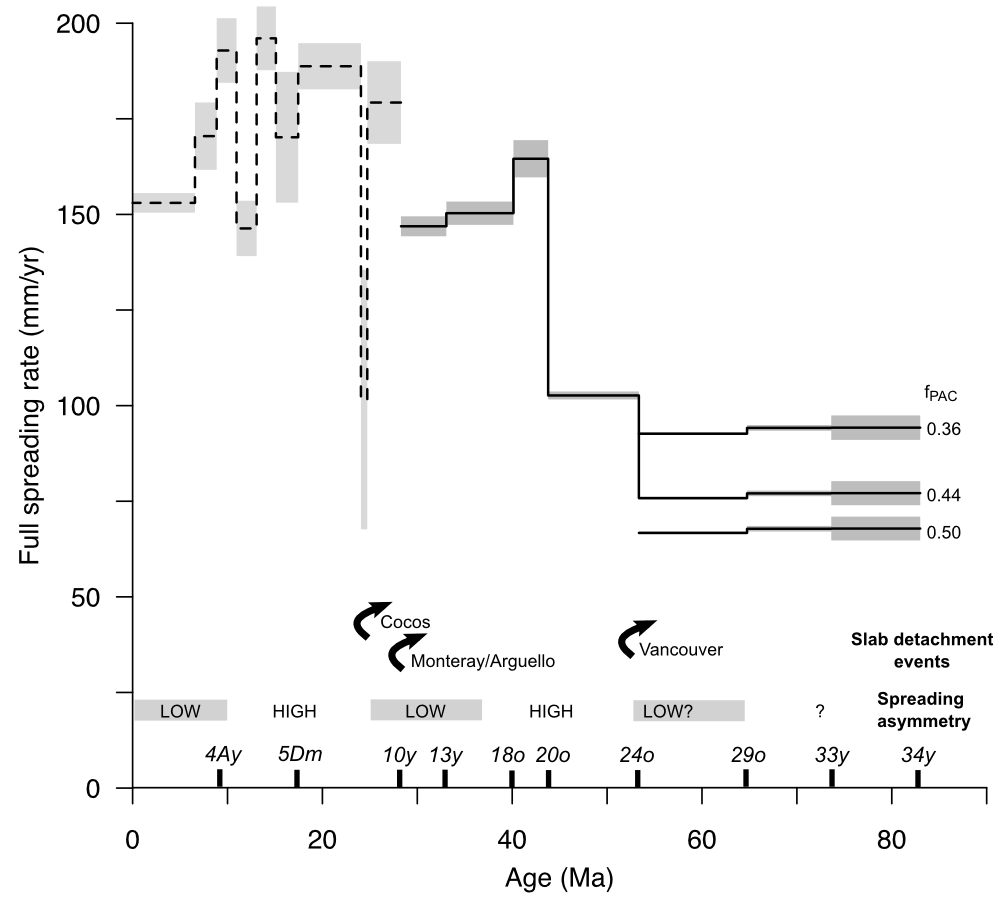New Paper: Spreading behaviour of the Pacific-Farallon ridge system since 83 Ma
Categories Papers, Plate Tectonics
In the Late Cretaceous, 83 million years ago, the Pacific ocean was dominated by the 10,000 km-long spreading ridge between the Pacific and Farallon plates. Since that time, the northern part of this ridge system has collided with the west coast of North America, leading to the progressive fragmentation of the Farallon plate, and its almost total subduction in the northern Pacific. In the southeast Pacific, the largest remanent is the ultrafast-spreading East Pacific Rise.

Because of their length and generally fast spreading rates, the Pacific-Farallon ridge and its descendents have produced a significant proportion – perhaps as much as 45% – of all the oceanic crust produced by all of the world’s ocean ridges in the past 83 million years. But because most of the conjugate Farallon Plate has been subducted beneath North America, reconstructing the detailed spreading history of this ridge system is not easy to reconstruct.
My latest paper, just out in Geophysical Journal International, presents improved rotations for the Pacific-Farallon Ridge between geomagnetic chrons 34y (83Ma) and 10y (28.28Ma). By fitting rotations between adjacent isochrons on the same (Pacific) plate, where magnetic anomaly and fracture zone traces are still preserved, the spreading history of the ridge system can be extrapolated. An additional complication is evidence for long-term spreading asymmetry on the EPR where old crust on the Farallon/Nazca side of the ridge is still present on the surface; we have calculated how this spreading asymmetry has changed over time where a record is available, and used this variation to provide conservative upper and lower bounds on the amount of Farallon plate spreading in the period prior to 51 Ma, where no record exists.

Our major conclusions:
- The average spreading rate of the ridge system has varied, with a major acceleration from fast to ultra-fast spreading rates at 55-48 Ma. The timing this acceleration coincides with the detachment of a major Farallon fragment (the Vancouver Plate); but in a plate tectonic system often assumed to be dominated by slab pull forces, one would predict deceleration.
- Fragmentation should also have altered the spatial distribution of slab pull forces, which one would expect to alter the position of the instantaneous Pacific-Farallon spreading pole. Instead, however, this pole was remarkably stable during the Late Cretaceous and Early Cenozoic.
- Our detailed analysis of variations in spreading asymmetry at the ridge in the past 50 Ma reveals a quasi-periodic 15–20 Myr variations in the degree of spreading asymmetry, with periods of higher asymmetry also appearing to correlate with increases in ridge spreading rate.
- One potential implication of these results is that forces other than slab pull, possibly acting at the ridge axis may be a factor in determining Pacific-Farallon Plate motions.
This research was part of my CIFAR-funded postdoctoral fellowship at the University of Chicago, under the supervision of co-author David Rowley.
A broader write-up of this paper is available at my public geology blog, Highly Allochthonous.
Rowan, C.J., and Rowley, D.B. (2014). Spreading behaviour of the Pacific-Farallon ridge system since 83 Ma. Geophys. J. Int., http://dx.doi.org/10.1093/gji/ggu056.